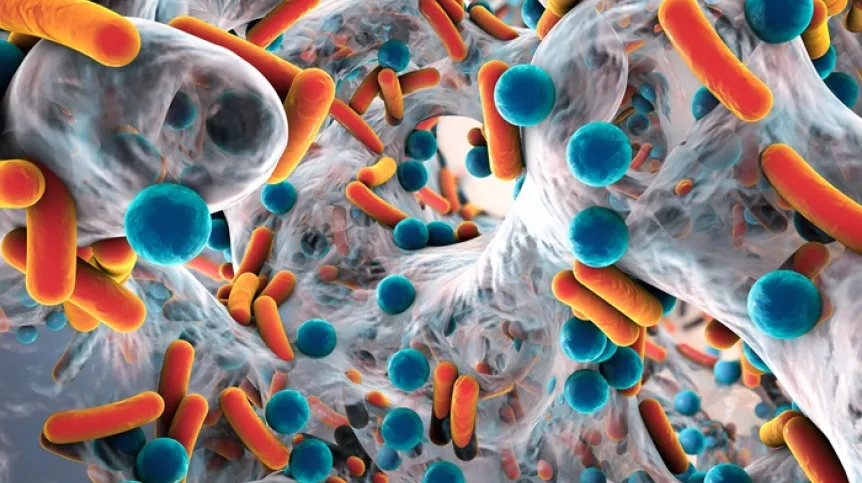
With bacterial resistance to antibiotics being a global health challenge, scientists are looking for new ways to combat microorganisms. A tool designed to accelerate work on new antibacterial compounds has been developed by Dr. Mateusz Rzycki from the Wrocław University of Science and Technology.
Diptool is a screening software for rapid, free energy-based determination of the affinity of an antimicrobial agent to various types of lipid membranes, including bacterial cell membranes. The tool models intermolecular interactions, which enables visualization of particle trajectories and analysis of their free energy. It is significantly faster than classic methods and has a user-friendly graphical interface; while working with it, researchers can run simulations with parameters they set and continuously monitor the results and various statistics in graphical form.
Research on completely new antibacterial compounds is very time-consuming, especially that there are millions of particles to test. The new tool can effectively accelerate this work.
Dr. Rzycki tells PAP that thanks to Diptool, a scientist can conduct virtual experiments on a computer even before a given chemical compound is synthesized in a lab. This opens up completely new possibilities when it comes to searching for new classes of detergents and antimicrobial agents. 'Our model is really simple. It enables quick extraction of certain molecules from large databases. Nowadays, such databases are absurdly huge, so it is good to have an assistant that, without using too much of our time and computer resources, is able to isolate the most promising compounds', Rzycki says.
Dr. Rzycki and colleagues: Professor Sebastian Kraszewski and Professor Marta Gładysiewicz-Kudrawiec from the Wrocław University of Science and Technology described the work on the Diptool tool and its effectiveness in papers published in Scientific Reports (https://doi.org/10.1038/s41598-024-55418-6) and Materials (https://doi.org/10.3390/ma14216455).
'Diptool allows us to evaluate selected antimicrobial compounds based on their properties. Thanks to it, we were able to propose an improved classification of these compounds in terms of their interactions with cell membranes and potential antimicrobial activity. This approach is of particular value in the analysis of particles and the development of new drugs targeting bacterial strains resistant to antibiotics', says Dr. Rzycki.
He began creating the tool as part of preparing his doctoral dissertation. He then began to wonder whether there were common features, e.g. structural ones, that all antibacterial compounds would exhibit. 'Together with the promoter, we were looking for parameters that would allow us to assess that compound A is more effective against a given bacterium than compound B', he says. There are many methods of such searches, but scientists were not satisfied with them. The main reason was that they could not be fully compared with each other, because they used different experimental protocols.
'That is why we, theoreticians, decided to approach this topic differently, reducing everything to numerical values. We used a method called QSAR', he adds.
QSAR (quantitative structure-activity relationship) is a technique that tries to link biological activity to various structural parameters of a given group of compounds. In the course of the research, it turned out that several of these parameters were repeated and could be considered significant. These included the dipole moment of the compounds, the partition coefficient and the size of the molecule (length to width ratio).
Then, Dr. Rzycki implemented these parameters in numerical form, using known methods of integrating equations of motion and dependencies of thermodynamic systems. 'There are certain numerical solutions that allow these laws to be applied to closed systems such as the ones we were dealing with. In our case, we limited everything to the interaction of dipoles with each other. That is, out of all previously isolated parameters, we focused exclusively on observations of the motion and energy of the system', he says.
The scientists prepared a model of a simplified lipid membrane, but they approached it a bit differently than is usually done. 'Our particle was represented by only one dipole with an appropriate value, and the membrane itself by a specific system of dipoles, determined based on previous studies in the field of molecular dynamics’, Rzycki continues. 'We then studied how the energy of such a system behaved, i.e. how some particles interacted with others'.
By observing how a given particle interacts with the membrane and calculating the energy associated with it, it was possible to assess whether a given compound was a good candidate for further experimental testing or not. In a word: whether it could be a potential antibacterial agent.
Dr. Rzycki adds that thanks to Diptool, the entire procedure is much faster than classical methods would allow. 'Our tool allows us to formulate similar conclusions, but it takes much less time. Studying one particle takes us minutes or hours, and in the case of traditional molecular dynamics methods, it takes days or weeks', he says. 'Diptool greatly speeds up the identification of promising compounds, which can then be tested experimentally by researchers'.
The tool's effectiveness is high. According to Dr. Rzycki, the activity of the particles characterized in Diptool was consistent with the results of previously used, classical tools. 'Our studies show that this method is promising and highly effective’, he says.
PAP - Science in Poland, Katarzyna Czechowicz
kap/ bar/ zan/
tr. RL













